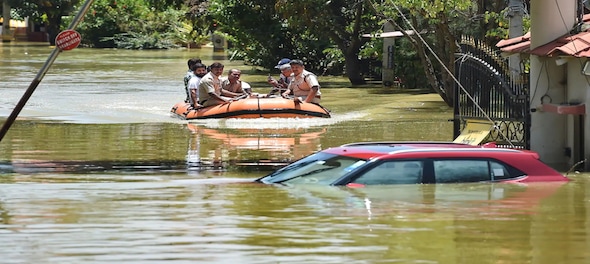
Incessant rain and and consequent waterlogging in many parts of Bengaluru have led to breakdown of a number of cars. If you are among those who owns one of these cars, you must be worried as post-flood repair costs can be high. However, if you have a comprehensive car insurance in place, you can contact your insurer to foot the repair bill.
Live TV
Loading...
A comprehensive car insurance covers losses or damages caused by natural calamities, such as floods, cyclones and hailstorms.
Basically, there are two types of damages caused by flood to any car — engine damage and accessories damage. Generally, the insurance companies cover both engine and upholstery damage, which could otherwise be very heavy on pocket. But if the engine and/or its parts receive any damage due to water ingress and oil leakage, a standard comprehensive policy doesn’t support it. This is where an add-ons would be necessary.
Here are the steps to raise a claim for flood-damaged cars:
Step 1:
Intimate the insurer by calling them at their toll-free or landline number. The number may be accessible on the website/app of the insurer. It may also be available in the email containing the policy PDF sent to the customer. Additionally, you can email the insurance partner to notify a claim.
Step 2: Share the details accurately such as information where the car was parked and all. You will be given a claim registration number.
Step 3: The car insurance company will schedule a pick-up time, tow your car to the garage and assign a surveyor.
Step 4: Collect substantial photo and video evidence that can be shared with the surveyor during vehicle inspection. After examining the damage extent, the claim amount would be conveyed to you.
Step 5: Once the repairs are done, and the payment settled (depending on reimbursement or payment made directly by the insurer to the garage partner), the customer’s car is ready to be back on the road again.
Meanwhile, insurance companies have informed customers about dos and don'ts to avoid further damage to motor vehicle. According to insurers, avoid driving in a water-logged area where water height is above the centre of the tire.
Do not switch on the ignition or attempt to start the car by jump-starting it —
even if the water has receded. Tow the vehicle to the nearest garage after disconnecting the battery. At the garage, ask the mechanic to do a thorough check of the car brakes (these have a higher chance of getting damaged as well), experts said.
Check out our in-depth Market Coverage, Business News & get real-time Stock Market Updates on CNBC-TV18. Also, Watch our channels CNBC-TV18, CNBC Awaaz and CNBC Bajar Live on-the-go!


In Ayodhya, voters talk of a promise fulfilled and yearning for development
May 17, 2024 2:10 PM
Fight of heavyweights in Sambalpur where farmers, weavers hold the key
May 17, 2024 12:25 PM
Odisha: Fight of heavyweights in Sambalpur where farmers, weavers hold the key
May 17, 2024 10:22 AM
Lok Sabha Election 2024: What rural Delhi wants
May 16, 2024 10:10 PM

